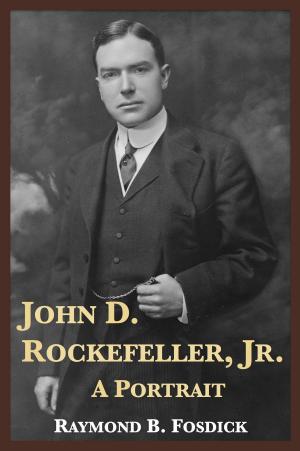The Death of an American Jewish Community: A Tragedy of Good Intentions
Nonfiction, Social & Cultural Studies, Current Events, Political Science, Government, Local Government, Social Science, Sociology, Urban| Author: | Hillel Levine, Lawrence Harmon | ISBN: | 1230000036997 |
| Publisher: | Plunkett Lake Press | Publication: | December 6, 2012 |
| Imprint: | Language: | English |
| Author: | Hillel Levine, Lawrence Harmon |
| ISBN: | 1230000036997 |
| Publisher: | Plunkett Lake Press |
| Publication: | December 6, 2012 |
| Imprint: | |
| Language: | English |
The Death of an American Jewish Community: A Tragedy of Good Intentions by Hillel Levine and Lawrence Harmon (128,000 words, 19 illustrations)
Written by a sociologist and a journalist, The Death of an American Jewish Community: A Tragedy of Good Intentions recounts the death of a Boston community once home to 90,000 Jews residing among African-Americans and white ethnics. The frightening personal testimonies and blatant evidence of manipulated housing prices illustrate how inadequate government regulation of banks can contribute to ethnic conflict and lives destroyed. “There were no winners,” the authors warn.
Hillel Levine and Lawrence Harmon believe that their findings may be true for American cities in general. Had we learned from what went wrong in Boston — blockbusting by a group of banks, federal programs promoting mortgages to people unable to afford them, real estate brokers seeking quick profits —, perhaps the 2008 nationwide real estate meltdown could have been anticipated. The lessons from this book are essential for students of ethnic relations and urban affairs.
“This candid, disturbing, and highly readable book recounts how Boston’s working-class Jewish neighborhoods were transformed into economically devastated black ghettoes.” — The New Yorker
“Bankers and real-estate brokers still shape the dynamics of daily life in our fragile urban neighborhoods. Levine and Harmon movingly capture the human side of this often destructive process in their story of redlining and blockbusting in Boston during the 1960s. But their book is more than history. It is a lesson about how to understand and improve our cities and neighborhoods, today and in the future.” — Raymond L. Flynn, Mayor of Boston, President, U.S. Conference of Mayors
“Levine and Harmon are sympathetic to the goals of racial integration but are indignant over the brutality and unfairness that accompanied these orchestrations. Bankers and politicians are indicted here by elaborate court evidence and by supplementary research cited by the authors, who use their insiders’ passion (Harmon was born and raised in Dorchester) and professional expertise to forever preserve the corned-beef flavor of old Blue Hill Avenue. As much an elegiac memory book of old Jewish Boston as a searing indictment against her killers.” — Kirkus Reviews
“Combines the rigor of good scholarship with the obsessive curiosity of good journalism” — J. Anthony Lukas, Author of Common Ground
“What keeps a community alive? What are the social and historical forces that shape or stifle its aspirations? When does a community soar and when does it yield to resignation? These and other questions take on an urgency of their own in Hillel Levine and Lawrence Harmon’s perceptive, brilliant, and disturbing inquiry.” — Elie Wiesel, University Professor and Andrew W. Mellon Professor in the Humanities, Boston University
“Levine and Harmon have written a prophetic indictment of the real estate speculation and elite indifference that, along with black crimes, destroyed Boston’s most vibrant Jewish neighborhoods. Have the courage to take their terrible journey; you will not return unchanged!” — Jim Sleeper, Author of The Closest of Strangers: Liberalism and the Politics of Race in New York
“This engagingly written and brilliantly illuminating portrait of the destruction of a vibrant Jewish community radically revises our understanding of the process of neighborhood change. The authors also break new ground in portraying the critical role of social class in American life and the powerful, if unconscious, class bias of Jewish communal leaders.” — Charles E. Silberman, Author of A Certain People: American Jews and Their Lives Today
The Death of an American Jewish Community: A Tragedy of Good Intentions by Hillel Levine and Lawrence Harmon (128,000 words, 19 illustrations)
Written by a sociologist and a journalist, The Death of an American Jewish Community: A Tragedy of Good Intentions recounts the death of a Boston community once home to 90,000 Jews residing among African-Americans and white ethnics. The frightening personal testimonies and blatant evidence of manipulated housing prices illustrate how inadequate government regulation of banks can contribute to ethnic conflict and lives destroyed. “There were no winners,” the authors warn.
Hillel Levine and Lawrence Harmon believe that their findings may be true for American cities in general. Had we learned from what went wrong in Boston — blockbusting by a group of banks, federal programs promoting mortgages to people unable to afford them, real estate brokers seeking quick profits —, perhaps the 2008 nationwide real estate meltdown could have been anticipated. The lessons from this book are essential for students of ethnic relations and urban affairs.
“This candid, disturbing, and highly readable book recounts how Boston’s working-class Jewish neighborhoods were transformed into economically devastated black ghettoes.” — The New Yorker
“Bankers and real-estate brokers still shape the dynamics of daily life in our fragile urban neighborhoods. Levine and Harmon movingly capture the human side of this often destructive process in their story of redlining and blockbusting in Boston during the 1960s. But their book is more than history. It is a lesson about how to understand and improve our cities and neighborhoods, today and in the future.” — Raymond L. Flynn, Mayor of Boston, President, U.S. Conference of Mayors
“Levine and Harmon are sympathetic to the goals of racial integration but are indignant over the brutality and unfairness that accompanied these orchestrations. Bankers and politicians are indicted here by elaborate court evidence and by supplementary research cited by the authors, who use their insiders’ passion (Harmon was born and raised in Dorchester) and professional expertise to forever preserve the corned-beef flavor of old Blue Hill Avenue. As much an elegiac memory book of old Jewish Boston as a searing indictment against her killers.” — Kirkus Reviews
“Combines the rigor of good scholarship with the obsessive curiosity of good journalism” — J. Anthony Lukas, Author of Common Ground
“What keeps a community alive? What are the social and historical forces that shape or stifle its aspirations? When does a community soar and when does it yield to resignation? These and other questions take on an urgency of their own in Hillel Levine and Lawrence Harmon’s perceptive, brilliant, and disturbing inquiry.” — Elie Wiesel, University Professor and Andrew W. Mellon Professor in the Humanities, Boston University
“Levine and Harmon have written a prophetic indictment of the real estate speculation and elite indifference that, along with black crimes, destroyed Boston’s most vibrant Jewish neighborhoods. Have the courage to take their terrible journey; you will not return unchanged!” — Jim Sleeper, Author of The Closest of Strangers: Liberalism and the Politics of Race in New York
“This engagingly written and brilliantly illuminating portrait of the destruction of a vibrant Jewish community radically revises our understanding of the process of neighborhood change. The authors also break new ground in portraying the critical role of social class in American life and the powerful, if unconscious, class bias of Jewish communal leaders.” — Charles E. Silberman, Author of A Certain People: American Jews and Their Lives Today















